Papers by Daniele Bocchiola

Soil water erosion is one of the challenges that the European Union should deal with in the next ... more Soil water erosion is one of the challenges that the European Union should deal with in the next years, due to its significant impacts on agriculture and natural hazards. In this work, a RUSLE (Revised Universal Soil Loss Equation)-like model has been applied to estimate soil water erosion in a Northern Italian Alpine basin (Val Camonica) by combining meteorological forcing with topography, soil properties and land cover. In the traditional formulation, land cover classes are assigned categorized cover management factor (Cfactor) value retrieved from existing literature (C-Land Cover formulation). However, Earth observation data have been proven effective in tuning the protective effect of vegetation on soil erosion dynamics. Thus, this method has been compared with two approaches (C-Satellite and C-Land Cover+Satellite) based on satellite-derived NDVI values to discretize C-factor values at a pixel scale. The C-Satellite formulation is based on an exponential law for correlating ob...
under a Creative Commons License. Transient catchment hydrology after wildfires in a Mediterranea... more under a Creative Commons License. Transient catchment hydrology after wildfires in a Mediterranean basin: runoff, sediment and woody debris Transient catchment hydrology after wildfires in a Mediterranean basin: runoff, sediment and woody debris
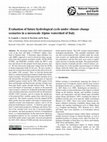
Natural Hazards and Earth System Sciences, 2011
We investigate future (2045-2054) hydrological cycle of the snow fed Oglio (≈1800 km 2) Alpine wa... more We investigate future (2045-2054) hydrological cycle of the snow fed Oglio (≈1800 km 2) Alpine watershed in Northern Italy. A Stochastic Space Random Cascade (SSRC) approach is used to downscale future precipitation from three general circulation models, GCMs (PCM, CCSM3, and HadCM3) available within the IPCC's data base and chosen for this purpose based upon previous studies. We then downscale temperature output from the GCMs to obtain temperature fields for the area. We also consider a projected scenario based upon trends locally observed in former studies, LOC scenario. Then, we feed the downscaled fields to a minimal hydrological model to build future hydrological scenarios. We provide projected flow duration curves and selected flow descriptors, giving indication of expected modified (against control run for 1990-1999) regime of low flows and droughts and flood hazard, and thus evaluate modified peak floods regime through indexed flood. We then assess the degree of uncertainty, or spread, of the projected water resources scenarios by feeding the hydrological model with ensembles projections consistent with our deterministic (GCMs + LOC) scenarios, and we evaluate the significance of the projected flow variables against those observed in the control run. The climate scenarios from the adopted GCMs differ greatly from one another with respect to projected precipitation amount and temperature regimes, and so do the projected hydrological scenarios. A relatively good agreement is found upon prospective shrinkage and shorter duration of the seasonal snow cover due to increased temperature patterns, and upon prospective increase of hydrological losses, i.e. evapotranspiration, for the same reason. However, precipitation patterns are less consistent, because HadCM3 and PCM models project noticeably increased precipitation for 2045-2054, whereas CCSM3 provides decreased precip
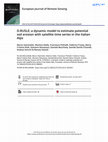
European Journal of Remote Sensing
Soil erosion is addressed as one of the main hydrogeological risks in the European Union. Since t... more Soil erosion is addressed as one of the main hydrogeological risks in the European Union. Since the average annual soil loss rate exceeds the annual average formation rate, soil is considered as a non-renewable resource. Besides, human activities, human-induced forces and climate change have further accelerated the erosion processes. Therefore, understanding soil erosion spatial and temporal trends could provide important information for supporting government land-use policies and strategies for its reduction. This paper describes the Dynamic Revised Universal Soil Loss Equation (D-RUSLE) model, a modified version of the well-known RUSLE model. The RUSLE model formulation was modified to include variations in rainfall erosivity and land-cover to provide more accurate estimates of the potential soil erosion in the Italian Alps. Specifically, the modelling of snow occurrence and the inclusion of Earth Observation data allow dynamic estimation of both spatial and temporal land-cover changes. Results obtained in Val Camonica (Italy) show that RUSLE model tends to overestimate erosion rates in Autumn/Winter because not considering snow cover and vegetation dynamics. The assimilation of satellite-derived information in D-RUSLE allows a better representation of soil erosion forcing, thus proving a more accurate erosion estimate for supporting government land-use policies and strategies for reducing this phenomenon.

Agricultural Water Management, 2013
ABSTRACT We studied the effect of prospective climate change upon crop yield, and related water f... more ABSTRACT We studied the effect of prospective climate change upon crop yield, and related water footprint of maize (Zea mays L.) for a relevant case study area in the Po valley of Northern Italy. To simulate maize production we used a cropping system simulation model CropSyst, which we set up and validated by way of crop yield data during 2001–2010. We then calculated the present water footprint (green, blue) of maize in the area, defined as the absolute and specific (per kg yield) amount of water evapotranspired during growing season, under three irrigation scenarios, namely (i) no irrigation, (ii) manual irrigation at fixed dates, and (iii) automatic irrigation on demand. We then evaluated the effects of prospective climate change upon maize production until mid-century (2045–2054), and we quantified the water footprint therein. We considered climate variations with focus upon temperature, precipitation, and CO2. First, we assessed maize yield and water footprint sensitivity to potential changes of these weather variables. We then fed the maize yield model with properly downscaled climate projections (storyline A2, business as usual) from global circulation models (GCM), included within the board of the Intergovernmental Panel of Climate Change, IPCC, and with those from a local scenario LOC, obtained by projecting recently observed local climate trends (1975–2010). Under the worst, more likely future scenarios of increasing temperature and decreasing precipitation, crop yield decreased and water footprint, especially blue, increased, due to increased evapotranspiration, higher irrigation demand, and lower final yield. Increase of CO2, albeit possibly increasing water use efficiency, seemed not to affect the water footprint noticeably. A possible increase of precipitation as projected by some GCMs, may partly make up for the increase of temperature, especially under a no, or little irrigation scenario, further diminishing the blue water footprint. Uncertainty in future precipitation has the greatest impact in scenarios projecting maize yield and water footprint. Our study provides hints as to how one can (i) evaluate the amount of water required to cultivate maize or other crops, and virtually traded when such crops are sold or bought, (ii) evaluate the impact of climate change upon water footprint and virtual water trade, and (iii) benchmark objectively adaptation strategies for agricultural systems with an eye on least water consumption.

Analysis of meteorological data is reported for the period 9 August- 11 October 2007, from an aut... more Analysis of meteorological data is reported for the period 9 August- 11 October 2007, from an automatic weather station(AWS) on Venerocolo Glacier, Adamello Group, Italy, aimed at studying the relationship between meteorological conditions and ablation on debris-covered ice. Venerocolo Glacier situated on the north side of Adamello, represents a recent debris-covered glacier and the first one in the Central Alps. Expansion of supraglacial debris cover(a few mm to 97 cm thick) is associated with the recent glacier shrinkage. The AWS (2621 m a.s.l.) is located on the debris-covered ablation area where the energy fluxes at the ice-debris-air interface are analyzed. The weather station on the glacier measured an average temperature of 4.4°C and wind speed of 1.7 ms-1. A mean albedo value of 0.2 was calculated and the liquid precipitation amount was of 250 mm. A network of 10 ablation stakes distributed in two cross and a longitudinal profiles on the debris-covered area were used to evaluate the measured ablation rates and to compare the results. Also thermistors were located at stakes to measure surface temperature of debris cover (max values of 30°C). The application of ablation models on debris-covered ice represents a challenge and a difficult task with varying characteristics of debris cover evidenced by meteorological data recorded at the glacier surface.
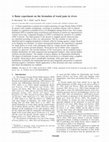
Water Resources Research, 2008
1] A flume experiment is carried out to explore jamming of Large Woody Debris (LWD) in streams wi... more 1] A flume experiment is carried out to explore jamming of Large Woody Debris (LWD) in streams with complex morphology, occurring in mountain streams with in channel boulders or vegetation, in braided rivers or in floodplains during flood events. Non rooted, defoliated LWD is modeled using wood dowels and obstacles to motion are represented by vertical wood rods. Congested transport of LWD is simulated by insertion of a number (100) of dowels. The final position of the dowels is mapped and the observed jams are classified according to their size and position. The key member of each jam is identified and its trapping mechanism evaluated, either by leaning against a single obstacle or by bridging two obstacles. To mimic uncongested transport, the experiment is repeated for single pieces of wood, with subsequent removal. Longer dowels and shallower water result in shorter traveled distance. Wood pieces travel farther when congested transport is observed. The traveled distance of the wood pieces can be modeled using a Gamma distribution, for both congested and uncongested transport. Jams instead display Uniform traveled distance. The number of pieces displays an Exponential distribution. The degree of uniformity in space of jams and wood pieces is evaluated using a neighbor K statistic. Wood pieces show considerable clustering, while jams show sparse distribution. Eventually, the relationship between jams magnitude and position is explored, showing negative correlation. Model application is then discussed and some conclusions and future developments are outlined.
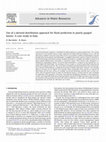
Advances in Water Resources, 2009
A derived distribution approach is developed for flood prediction in poorly gauged basins. This c... more A derived distribution approach is developed for flood prediction in poorly gauged basins. This couples information on the expected storm scaling, condensed into Depth Duration Frequency curves, with soil abstractions modeled using Soil Conservation Service Curve Number method and hydrological response through Nash's Instantaneous Unit Hydrograph. A simplified framework is given to evaluate critical duration for flood design. Antecedent moisture condition distribution is included. The method is tested on 16 poorly gauged Mediterranean watersheds in Tyrrhenian Liguria, North Western Italy, belonging to a homogeneous hydrological regions. The derived flood distribution is compared to the regional one, currently adopted for flood design. The evaluation of Curve Number is critical for peak flood evaluation and needs to be carefully carried out. This can be done including local Annual Flood Series data in the estimation of the derived distribution, so gathering the greatest available information. However, Curve Number influence decreases for the highest return periods. When considerable return periods are required for flood design and few years of data are available, the derived distribution provides more accurate estimates than the approach based on single site distribution fitting. A strategy based on data availability for application of the approach is then given. The proposed methodology contributes to the ongoing discussion concerning PUB (Prediction in Ungauged Basins) decade of the IAHS association and can be used by researchers and practitioners for those sites where no flood data, or only a few, are available, provided precipitation data and land use information are at hand.
Cold Regions Science and Technology, 2010
Spatial estimation of snow water equivalent SWE at six different dates from February 1st to June ... more Spatial estimation of snow water equivalent SWE at six different dates from February 1st to June 1st is tackled using Kriging from a sparse network of 14 snow stakes with density within the Adamello Natural Park of Italy. Therein, SWE is measured at these six dates for the period 1967–2009. Second order statistics of SWE are evaluated and linked to
Journal of Hydrology, 2006
Rainfall simulator experiments were carried out in the Liguria region, Italy, immediately after a... more Rainfall simulator experiments were carried out in the Liguria region, Italy, immediately after a forest fire in early August, 2003, to evaluate the effects of forest fire on soil hydraulic properties, runoff and erosion.
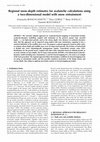
Annals of Glaciology, 2008
The currently adopted approach for avalanche-hazard mapping in Switzerland includes avalanche-dyn... more The currently adopted approach for avalanche-hazard mapping in Switzerland includes avalanche-dynamics modelling coupled with estimation of the greatest annual 3 day snowfall depth, H 72 , for high-return periods, used as the release depth. New advances in avalanche dynamics show that this approach can be improved using models with mass entrainment, requiring in turn a statistical definition of the erodible snow cover. We propose a regional approach, based on index value, to evaluate release depth and erodible snow cover for large-return periods. The territory of Switzerland is divided into seven climatologically homogeneous regions. Generalized extreme value (GEV) distributions for the growth factors coupled with index-value estimation based on altitude provide an accurate estimate of snow depths, also for large-return periods. RAMMS, a two-dimensional avalanchedynamics model including snow entrainment, is used for hazard mapping for a site used as an example of the Swiss procedure. The regional approach allows the boundary conditions for hazard mapping to be set using an entrainment model, and also provides statistical uncertainty of the design release and erosion depth, thus aiding in applying uncertainty analysis to hazard-mapping procedure.
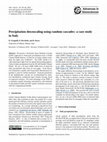
Advances in Geosciences, 2010
We present a Stochastic Space Random Cascade (SSRC) approach to downscale precipitation from a Gl... more We present a Stochastic Space Random Cascade (SSRC) approach to downscale precipitation from a Global Climate Model (hereon, GCMs) for an Italian Alpine watershed, the Oglio river (1440 km2). The SSRC model is locally tuned upon Oglio river for spatial downscaling (approx. 2 km) of daily precipitation from the NCAR Parallel Climate Model. We use a 10 years (1990-1999) series of observed daily precipitation data from 25 rain gages. Scale Recursive Estimation coupled with Expectation Maximization algorithm is used for model estimation. Seasonal parameters of the multiplicative cascade are accommodated by statistical distributions conditioned upon climatic forcing, based on regression analysis. The main advantage of the SSRC is to reproduce spatial clustering, intermittency, self-similarity of precipitation fields and their spatial correlation structure, with low computational burden.

Advances in Water Resources, 2010
ABSTRACT We develop a simple model to evaluate the daily flow discharges in the ablation season f... more ABSTRACT We develop a simple model to evaluate the daily flow discharges in the ablation season for the 11 km2 Pantano basin in the Retiche Italian Alps, based upon the data gathered during a three years field campaign. The Pantano basin embeds the Venerocolo debris covered and the Avio debris free glaciers, covering 2.14 km2 in the Adamello Group, where the widest Italian glacier Adamello is located. First, degree-day models based upon air temperature are tuned to calculate snow and ice melt at daily scale. Glaciers’ meteorological data are collected from an automatic weather station (AWS), operating on the glacier during summer 2007. The melt factors in the debris covered areas of the glacier are estimated against debris thickness, using a data driven parameterization. The flow discharge from the catchment is estimated using semi distributed flow routing for the ablation seasons of four years, from 2006 to 2009. The predicted discharges are compared to those derived from inverse reservoir's routing at the Benedetto lake, catching the basin outflow. The proposed approach is valuable as a tool to investigate the hydrology of poorly gauged glacierized areas, including those with debris covered ice, widely diffused and yet poorly understood. Pending accurate parameterization the approach is usable for water resources evaluation and for long term assessment of the climate change impact on the glacierized areas within the Alps.
Arctic Antarctic and Alpine Research, 2009
ABSTRACT
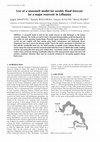
Annals of Glaciology, 2008
A snowmelt model is used for the weekly forecast of daily discharges in the Kaunas reservoir, Lit... more A snowmelt model is used for the weekly forecast of daily discharges in the Kaunas reservoir, Lithuania. The results are used to feed a risk-based decision-making model developed by the first author for dam operation during floods. Physically based calibration of a degree-day model is carried out and coupled with flow routing using Nash's instantaneous unit hydrograph theory. Temperature forecast is used as the driving variable. Due to the relative smoothness of snowmelt over time and the considerable basin size, the model provides acceptable results. Kalman filtering is then used to merge the estimates from the snowmelt model with those from an ARIMA flow model, resulting in better forecasting than that using each method alone. Uncertainty analysis of the snowmelt-model results is then carried out, showing considerable influence of the main parameter degree-day and of soil moisture conditions. Therefore these must be accurately estimated for forecasting purposes during flood events.
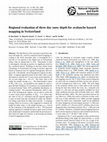
Natural Hazards and Earth System Sciences, 2008
The distribution of the maximum annual three day snow fall depth H 72 , used for avalanche hazard... more The distribution of the maximum annual three day snow fall depth H 72 , used for avalanche hazard mapping according to the Swiss procedure (Sp), is investigated for a network of 124 stations in the Alpine part of Switzerland, using a data set dating back to 1931. Stationarity in time is investigated, showing in practice no significant trend for the considered period. Building on previous studies about climatology of Switzerland and using an iterative approach based on statistical tests for regional homogeneity and scaling of H 72 with altitude, seven homogenous regions are identified. A regional approach based on the index value is then developed to estimate the T -years return period quantiles of H 72 at each single site i, H 72i (T ). The index value is the single site sample average µ H 72i . The dimensionless values of H * 72i =H 72i /µ H 72i are grouped in one sample for each region and their frequency of occurrence is accommodated by a General Extreme Value, GEV, probability distribution, including Gumbel. The proposed distributions, valid in each site of the homogeneous regions, can be used to assess the T -years return period quantiles of H * 72i . It is shown that the value of H 72i (T ) estimated with the regional approach is more accurate than that calculated by single site distribution fitting, particularly for high return periods. A sampling strategy based on accuracy is also suggested to estimate the single site index value, i.e. the sample average µ H 72i , critical for the evaluation of the distribution of H 72i . The proposed regional approach is valuable because it gives more accurate snow depth input to dynamics models than the present procedure based on single site analysis, so decreasing uncertainty in hazard mapping procedure.
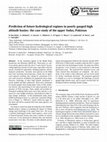
Hydrology and Earth System Sciences Discussions, 2011
In the mountain regions of the Hindu Kush, Karakoram and Himalaya (HKH) the "third polar ice cap"... more In the mountain regions of the Hindu Kush, Karakoram and Himalaya (HKH) the "third polar ice cap" of our planet, glaciers play the role of "water towers" by providing significant amount of melt water, especially in the dry season, essential for agriculture, drinking purposes, and hydropower production. Recently, most glaciers in the HKH have been retreating and losing mass, mainly due to significant regional warming, thus calling for assessment of future water resources availability for populations down slope. However, hydrology of these high altitude catchments is poorly studied and little understood. Most such catchments are poorly gauged, thus posing major issues in flow prediction therein, and representing in facts typical grounds of application of PUB concepts, where simple and portable hydrological modeling based upon scarce data amount is necessary for water budget estimation, and prediction under climate change conditions. In this preliminarily study, future (2060) hydrological flows in a particular watershed (Shigar river at Shigar, ca. 7000 km2), nested within the upper Indus basin and fed by seasonal melt from major glaciers, are investigated. The study is carried out under the umbrella of the SHARE-Paprika project, aiming at evaluating the impact of climate change upon hydrology of the upper Indus river. We set up a minimal hydrological model, tuned against a short series of observed ground climatic data from a number of stations in the area, in situ measured ice ablation data, and remotely sensed snow cover data. The future, locally adjusted, precipitation and temperature fields for the reference decade 2050-2059 from CCSM3 model, available within the IPCC's panel, are then fed to the hydrological model. We adopt four different glaciers' cover scenarios, to test sensitivity to decreased glacierized areas. The projected flow duration curves, and some selected flow descriptors are evaluated. The uncertainty of the results is then addressed, and use of the model for nearby catchments discussed. The proposed approach is valuable as a tool to investigate the hydrology of poorly gauged high altitude areas, and to project forward their hydrological behavior pending climate change.

Analysis of meteorological data is reported for the period 9 August- 11 October 2007, from an aut... more Analysis of meteorological data is reported for the period 9 August- 11 October 2007, from an automatic weather station(AWS) on Venerocolo Glacier, Adamello Group, Italy, aimed at studying the relationship between meteorological conditions and ablation on debris-covered ice. Venerocolo Glacier situated on the north side of Adamello, represents a recent debris-covered glacier and the first one in the Central Alps. Expansion of supraglacial debris cover(a few mm to 97 cm thick) is associated with the recent glacier shrinkage. The AWS (2621 m a.s.l.) is located on the debris-covered ablation area where the energy fluxes at the ice-debris-air interface are analyzed. The weather station on the glacier measured an average temperature of 4.4°C and wind speed of 1.7 ms-1. A mean albedo value of 0.2 was calculated and the liquid precipitation amount was of 250 mm. A network of 10 ablation stakes distributed in two cross and a longitudinal profiles on the debris-covered area were used to evaluate the measured ablation rates and to compare the results. Also thermistors were located at stakes to measure surface temperature of debris cover (max values of 30°C). The application of ablation models on debris-covered ice represents a challenge and a difficult task with varying characteristics of debris cover evidenced by meteorological data recorded at the glacier surface.
Geomorphology, 2006
Flume experiments were carried out to investigate the motion of large woody debris (LWD) in river... more Flume experiments were carried out to investigate the motion of large woody debris (LWD) in rivers as influenced by the presence of obstacles. Non-rooted, defoliated LWD was modelled by placing properly scaled wooden dowels placed into controlled water flow. Obstacles were represented by wooden rods randomly placed into the flume with a specified probability distribution. The results provide the probability of lodging of the dowels and statistics of the distance travelled. Their relationships with flow rate and depth, dowel length and spatial density of the obstacles is explored. This yields a general theoretical framework to approach LWD transport in rivers by combining random factors with deterministic dimensionless variables. D

Water Resources Research, 2008
1] A flume experiment is carried out to explore jamming of Large Woody Debris (LWD) in streams wi... more 1] A flume experiment is carried out to explore jamming of Large Woody Debris (LWD) in streams with complex morphology, occurring in mountain streams with in channel boulders or vegetation, in braided rivers or in floodplains during flood events. Non rooted, defoliated LWD is modeled using wood dowels and obstacles to motion are represented by vertical wood rods. Congested transport of LWD is simulated by insertion of a number (100) of dowels. The final position of the dowels is mapped and the observed jams are classified according to their size and position. The key member of each jam is identified and its trapping mechanism evaluated, either by leaning against a single obstacle or by bridging two obstacles. To mimic uncongested transport, the experiment is repeated for single pieces of wood, with subsequent removal. Longer dowels and shallower water result in shorter traveled distance. Wood pieces travel farther when congested transport is observed. The traveled distance of the wood pieces can be modeled using a Gamma distribution, for both congested and uncongested transport. Jams instead display Uniform traveled distance. The number of pieces displays an Exponential distribution. The degree of uniformity in space of jams and wood pieces is evaluated using a neighbor K statistic. Wood pieces show considerable clustering, while jams show sparse distribution. Eventually, the relationship between jams magnitude and position is explored, showing negative correlation. Model application is then discussed and some conclusions and future developments are outlined.











Uploads
Papers by Daniele Bocchiola